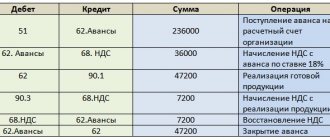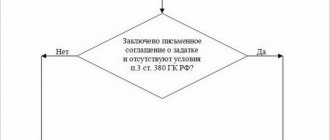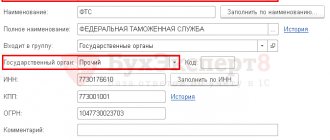What are accounting entries and how to conduct them correctly? According to the Federal Law of the Russian Federation “On Accounting”, all organizations carrying out business activities as legal entities are required to maintain accounting records. Based on this Law, the “Regulations on accounting and financial reporting in the Russian Federation” were adopted, which explains the necessary principles.
What is an accounting account?
It is very difficult for novice accountants to understand the preparation of entries without a clear understanding of what an account is, so it is better to move “from the stove”.
An accounting account is a certain position in business accounting necessary for continuous monitoring of the ongoing movement of property owned by the company, as well as the sources of its formation. This is done by using the double entry method, when one transaction is reflected twice - as a debit to one account and as a credit to another. All accounts that are used in the accounting of commercial companies are systematized and grouped in a special document - the chart of accounts.
Advice: when analyzing transactions and making entries, it is best to keep at hand the general chart of accounts for accounting the financial and economic activities of organizations.
Accounting accounts are divided into three types depending on what object is subject to accounting:
- Active – designed to display in monetary terms information about the organization’s economic assets and resources. For example, materials (10), cash in the cash register (50), finished products (43), etc. The opening balance of active accounts is recorded only by debit, the ending balance is the same. Transactions that are characterized by an increase in the company's funds are indicated as a debit of the account. If resources decrease, the entry is credited.
- Passive - they take into account in monetary terms the state, movements and changes in the sources through which the company’s economic assets were formed. For example, depreciation of fixed assets (02), trade margin (42), authorized capital (80), etc. The opening and closing balances can only be for the loan. Entries that increase the account go to credit, and those that decrease it go to debit.
- Active-passive – insidious accounts that play the role of both passive and active. It is important to understand which account sign is triggered in each specific situation. The opening balance can be recorded both as a debit and as a credit; It is possible to have a debit and credit opening balance at the same time. For example, active-passive account 76 “Settlements with various debtors and creditors.” If a company has accounts receivable (that is, someone owes it), then the amount is written as a debit, and in the case of accounts payable (the company owes someone), the figure is reflected as a credit.
When accountants were forced to carry out calculations without using a computer, accounts were drawn in the form of original tablets, which were popularly called “airplanes.” Each account has its own scheme, they look like this.
- Typical active account scheme:
- Typical passive account scheme:
- Typical active-passive account scheme:
Lesson 3 Conclusions
Lesson 3 Summary:
- An accounting account is a table with two columns (debit/credit), the purpose of which is to record transactions performed.
- The standard Plan contains 99 balance sheet accounts and 11 off-balance sheet accounts.
- Based on the standard account plan, a working plan is created from the required list of accounts.
- Accounting accounts are: synthetic and analytical, active, passive and active-passive; on-balance sheet and off-balance sheet.
- Information on synthetic accounts is shown in Russian rubles, on analytical accounts - in any convenient meter.
How are accounting entries prepared?
Accounting entries are based on the principle of double entry: the transaction amount is recorded as a debit to one account and a credit to another, that is, a balance is always maintained, which is why the asset must always be equal to the liability.
Example: suppose the founder of an LLC made a contribution to the authorized capital in the amount of 10,000 rubles by depositing the money into a current account. Then we can draw the following conclusion - the company acquired assets (cash), and at the same time, obligations to the founder arose. The result will be the following double entry: Dt 51 “Current account” – Kt 80 “Authorized capital” – 10,000 rubles.
The meaning and essence of the wiring is easy to understand if you realize that nothing in this world comes out of nowhere and disappears without a trace. Everything is logical - we bought the materials, which means we paid money for them. In other words, there was an increase in materials, but a decrease in finances. There is an interesting point here: movement between items can occur without changing the total for assets and liabilities. For example, the production of goods was completed, therefore, they became finished goods. Two active accounts were affected - one decreased and the other increased by the same amount. Posting in this situation: Dt 43 “Finished products” - Kt 20 “Main production” .
See also: Online trading platforms for individuals
And if a company pays a debt to a supplier from a current account, then there will be a simultaneous decrease in assets and liabilities, since this operation affects the active cash account and the active-passive (the passive sign is triggered, as our company must) account reflecting accounts payable. Posting: Dt 60 “Settlements with suppliers and contractors” – Kt 51 “Settlement account” .
Standard Chart of Accounts
An accountant does not need to come up with his own accounts for bookkeeping.
The Ministry of Finance of the Russian Federation, by its order No. 94n dated October 31, 2000, approved a standard accounting plan, which presents a list of accounting accounts that can be used for accounting. The plan contains:
- 8 sections with a list of balance sheet accounts with numbers from 01 to 99 - the main ones where transactions are recorded.
- 1 section with a list of off-balance sheet accounts with numbers from 001 to 011 - auxiliary, where records are kept of assets and liabilities that are not owned by the company (leased, in temporary storage, for commissions, guarantees issued and received).
Balance sheet data shows the amounts of a business's assets and liabilities and is used to prepare a balance sheet. They have numbers from 01 to 99, but now only 62 are used, the remaining numbers are spare and can be used by the company for its own purposes in accordance with the specifics of its activity if there are not enough available accounts.
Data from off-balance sheet accounts are not shown in the balance sheet and are necessary to reflect property and liabilities that do not belong to the company - assets under lease, under storage, commissions accepted for installation, strict reporting forms, guarantees, non-recoverable receivables.
Structure of a standard Plan:
Work plan
An enterprise is not obliged to apply all accounting accounts included in the standard accounting plan.
The company has the right to select the necessary accounts - the Work Plan, and prescribe this list in the Order on accounting policies.
.
Accounting entries for specific business transactions
The number of balance sheet accounts approaches a hundred - of course, this is a lot, especially if you remember that some have numerous sub-accounts. This diversity leads to complications: there are a great many typical accounting entries - just imagine all the possible combinations. Moreover, it must be borne in mind that some transactions are recorded not in one, but in several transactions. It is probably impossible to consider all the options, but it is quite possible to highlight those that most organizations face. Let's discuss different cases, presenting information with answers in tables.
For fixed assets accounting
Fixed assets are tangible assets that are directly involved in production processes and are present in the activities of many companies (buildings, structures, transport, tools and even perennial crops and breeding livestock). Their distinctive feature is the period of use - it must exceed one year. For example, fixed assets (PE) include production equipment. Everyone understands that you can work with it for more than 12 months, but over time, its useful life expires, that is, banal wear and tear occurs. Therefore, the cost of fixed assets is gradually transferred to the cost of production through depreciation.
Let us present in the table the postings-responses for those typical accounting transactions that relate to fixed assets:
Fixed assets are accepted for accounting at their original cost, which is the sum of all costs associated with the acquisition of an asset. That is, this includes not only the direct costs of purchasing an OS or its construction, but also the cost of delivery, installation, consulting services, and the like. However, we must remember that, in accordance with PBU 6/01, assets whose value does not exceed 40,000 rubles can be reflected in accounting as part of inventories (inventory) - their receipt is reflected in account 10 “Materials”.
By accounting for intangible assets
A company's intangible assets have no physical form, yet they are capable of generating economic benefits and can be clearly identified. For example, intangible assets include the business reputation of a company and various objects of intellectual property - you cannot touch it with your hands, but exclusive rights to something (a trademark, a program, breeding achievements, etc.) often make it possible to receive significant income.
See also: How to write a letter of recommendation for an employee - sample
Answers to the main questions related to accounting of intangible assets are presented in the table:
Organizational expenses incurred during the formation of a legal entity cannot be classified as intangible assets (PBU 14/07).
According to inventory accounting
All companies involved in manufacturing are constantly faced with the need to purchase materials (inventory, or inventories). As a rule, even for novice accountants, their accounting does not cause difficulties - the answers and postings for typical transactions can be seen in the table:
Nowadays, fuel cards are widely used by many organizations whose activities are closely related to transport. Novice financiers often have difficulties with accounting for fuel and lubricants on fuel cards, since at present there is no clear legally approved procedure for carrying out this procedure - some believe that account 10 “Materials” can be used, but experts say that this approach is incorrect and advise use off-balance sheet accounts.
Advice: several years ago, a universal transfer document specially developed by the Federal Tax Service came into use among accountants, but not all companies wanted to get acquainted with it, fearing innovations. If you do not yet use UPD, then you should think about changing the situation, since this will allow you to significantly reduce document flow, and therefore significantly save time.
By accounting for production costs
For people starting to understand the preparation of accounting entries, it is sometimes quite problematic to deal with the accounting of production costs, because several accounts are intended for them. Usually, the accounting policy of the organization prescribes how the valuation of retiring inventories occurs (PBU 5/01). Let's look at the answers to the most common situations in the table:
Production cost accounts include 20, 21, 23, 25, 26, 28, 29.
For accounting of finished products and goods
Many companies build their business on the sale of any goods, so it is important for novice accountants to understand how their accounting is carried out. Answers in the form of entries for typical business transactions involving the purchase and sale of marketable products can be found in the table:
If an organization is engaged in purchasing goods from suppliers, then great attention should be paid to checking the documentation provided by the counterparty. Remember that you have the right not to rush joyfully to the first offer if it seems unprofitable. In this case, a protocol of disagreements to the contract is usually drawn up, reflecting the position of the party who disagrees with any of the terms.
Important: the table shows only the basic standard accounting entries - in the accounting of goods and finished products, there are a lot of options possible, since they often need to be revalued and are sometimes made as a contribution to the authorized capital (or in general the company receives them for free). To become familiar with all situations, it is necessary to study in detail the Accounting Regulations and other special literature.
Cash accounting
While not all companies deal with the production of products, probably absolutely all of them work with money. For financial accounting, two accounts are most often used - 50 “Cash” and 51 “Current account”. From the names it is intuitively clear - money is usually stored either in the cash register or in a bank account. Let's look at typical transactions in the table that affect the organization's funds and give the answers in the form of transactions:
Novice accountants should remember that when carrying out transactions with funds, the appropriate documentation must be drawn up - payment orders, cash receipts and debit orders, advance reports, cash inventory reports, etc.
According to settlements with staff
Partial answers to questions on typical accounting entries affecting the payment of employees were given above; To make the information easier to perceive, we group them in a table:
See also: How to create your own group in Odnoklassniki for free?
Accounting for loans and borrowings
Who hasn’t needed a loan in these difficult times? Entrepreneurs are no exception - often business development requires additional financial investments, and there is simply nowhere to get them... Then businessmen usually go to banking institutions. Novice accountants will be able to process “credit” transactions without any problems, because there are not many options here - you need to reflect the loan received, calculate the monthly loan payment, etc. For clarity, we present typical postings-responses in the table:
The table most often contains two accounts - 66 and 67. You need to choose depending on the loan term: account 66 is called “Calculations for short-term loans and borrowings,” and 67 is called “Calculations for long-term loans and borrowings.”
For transactions with authorized capital
Authorized capital is financial funds or any property that the founders contributed during the registration of the LLC. There is an opinion in society that a contribution to a management company necessarily represents money, but this is not at all true - if you are the owner of a building, then, of course, you can become the founder of an LLC by contributing your real estate to the authorized capital. What else can you use as a contribution? We will answer this question in the table, giving typical entries for accounting of authorized capital:
For accounting of financial results
Of course, the goal of any business activity is to generate income. The financial result is determined by the profit or loss generated by the end of the reporting period. If income exceeds expenses, then the property of the enterprise increases, that is, the company makes a profit; in the opposite situation, there is a loss. Let's consider in the table how entries are made for transactions related to the formation of the financial result:
Account 90 “Sales” reflects revenue as a debit, and as a credit – costs that relate to cost, as well as excise taxes and taxes. When the balance of account 90 is in credit at the end of the period, profit is recognized. If the balance is debit, then the company has incurred a loss. It should be remembered that account 99 is written off to 84 on the last day of the reporting period, that is, its balance becomes zero.
Reflection of income, expenses and financial results
| Operation | Debit | Credit |
| Income and expenses from core activities | ||
| Sales revenue reflected | 62 | 90 |
| VAT charged on the sales amount | 90 | 68 |
| Reflects the cost of goods sold, products, services rendered | 90 | 41, 43, 20 |
| Write-off of management expenses reflected | 90 | 26 |
| Business expenses written off | 90 | 44 |
| Other income and expenses | ||
| Income received from other sales | 62 | 91 |
| Cost of materials sold written off | 91 | 10 |
| Interest accrued on received loans and borrowings | 91 | 66, 67 |
| Interest accrued on issued loans and borrowings | 66, 67 | 91 |
| Financial results | ||
| Profit received from sales is reflected | 90 | 99 |
| The loss received from the sale is reflected | 99 | 90 |
| Positive results from other activities | 91 | 99 |
| Negative result from other activities | 99 | 91 |
| Profit tax accrued | 99 | 68 |
| Retained earnings are reflected at the end of the year | 99 | 84 |
| Based on the results of the year, the resulting loss is reflected | 84 | 99 |
| A decision was made to pay dividends | 84 | 75 |
| Dividends transferred to founders | 75 | 51 |
Is it possible to make transactions online?
Today, many Internet services lure novice accountants with the opportunity to make transactions online - automatically, free of charge and in real time. Of course, no one forbids taking advantage of the offer, but it is worth understanding that the business operations of each specific company have their own subtleties and nuances, so it is easy to end up with incorrectly formed accounting entries. It is logical that a person involved in accounting should know the chart of accounts and PBU by heart, and the owners of this information usually do not need help in analyzing business transactions.
Important: if you still do not want to prepare accounting entries yourself, then it is better to use special software, for example 1C: Accounting.
Compilation rules
They must be displayed in the document through which the business transaction is carried out, a statement or journal used for records or in memorial orders. The last option contains instructions. It instructs to record a business transaction in accordance with the relevant accounting accounts.
To facilitate the work, it is provided that each account receives a specific number. Thanks to this, you can specify shorter numbers rather than names. Grouping when recording business transactions is carried out according to economically homogeneous characteristics. Simple mapping is called systematic notation. But registration of ongoing business transactions can also be carried out in the sequence of completion. This is already a chronological entry. Differences in the economic content of transactions performed are not taken into account.
Makes complex things clear to an accountant
Off-balance sheet accounts stand apart. They are used to summarize available information affecting the presence and movement of values. Their values do not correspond with other accounts. Records are kept exclusively one-sided. They can be either debit (increase) or credit (decrease). The values are not indicated in the balance sheet, since they are already displayed, albeit in a somewhat blurred form, on other accounts.
Goods
Every enterprise that conducts business activities has commodity-material assets. Below is a list of most accounting entries for goods:
- Accounting for goods in accounting: postings, examples, laws
- Revaluation of goods in accounting entries
- Movement of goods through warehouses: postings, rules, examples
- Resale of goods between the commission agent and the principal in accounting
- Reflection of goods in storage in accounting entries
- Accounting entries for the transfer of goods free of charge
- Accounting accounts and entries for payment for goods and services
- Accounting for goods in transit
- Consignment goods: the relationship between the consignor and the commission agent
- Carrying out an inventory: receipt of surpluses and write-off of shortages
- How goods are shipped in accounting entries using an example
- Postings for the purchase of goods and services
- Postings for the sale of goods and services
- Returning goods to the supplier: reasons, posting tables, examples
- Postings for receipt of goods to the warehouse
- How to reflect the return of goods from a buyer in accounting
- Write-off of goods in case of shortage or damage in accounting entries
- Postings according to additional costs for delivery of goods
Fixed assets
- Accounting entries for fixed assets
- Liquidation of fixed assets: postings, complete wear and tear
- Basic accounting entries for the sale of fixed assets
- Revaluation of fixed assets in accounting
- Postings for repair and modernization of the OS
- Accounting entries for fixed assets in budgetary organizations
- Accounting entries for revaluation of fixed assets
- Accounting entries for the acquisition of fixed assets
- Accounting entries for the transfer of fixed assets
- Typical accounting entries for write-off transactions of fixed assets
- Accounting entries for depreciation of fixed assets
- Accounting entries upon receipt of fixed assets
- Renting and leasing of fixed assets in accounting
Settlements with buyers and suppliers
- Bills of exchange in accounting entries for mutual settlements
- Postings on account 60
- Postings under an agency agreement - how the principal and agent keep records
- We reflect acquiring in accounting entries
- Typical accounting entries to reflect bank commissions
- Uncollectible accounts receivable in accounting entries
- Commission agreement in accounting from the point of view of the commission agent
- Accounts receivable in accounting
- Transactions on assignment of debt between legal entities
- Basic accounting entries for account 62
- Adjustment of receipts in accounting
- Adjustment of sales in the current and previous periods in accounting
- Postings to accounts payable
- How to make accounting entries when returning funds to a buyer or supplier
- Postings under the agency agreement with the principal
- Assignment agreement - postings, examples, laws
- Commission trading from the principal's point of view: how to prepare accounting entries and legislation
- Postings for debt adjustments: offset, transfer and write-off of debt
- Postings for doubtful debts
- Accounting entries for advances from customers
- Debts of buyers and suppliers in accounting
Materials
- Postings by materials (account 10)
- Stationery in accounting - postings, accounting accounts, examples
- Postings for returnable packaging
- Accounting entries for workwear
- Transport and procurement costs in accounting
- Postings for reflecting excess materials. postings
- Postings for the return of materials
- Inventory of materials: accounting entries
- Accounting entries for transactions with customer-supplied raw materials
- Typical postings for material shortages
- Purchasing materials from a supplier - accounting entries
- Posting sales of materials on prepayment and after payment
- Postings: receipt of materials to the warehouse
- Online accounting entries for writing off materials for production, damage, sale









